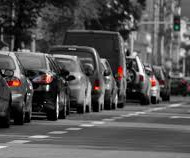4/21/2016
2012 Study: Red Light Cameras Cause Traffic JamsMaryland researchers conclude that red light cameras have a huge negative impact on intersection traffic flow.

Local officials attribute many benefits to the use of red light cameras, but they rarely mention any negative side effects. A 2012 paper by Maryland researchers documented a downside -- an increase in congestion at intersections where automated ticketing machines are in use.
"Given the continuous monitoring of intersections by red light cameras, the cumulative impact of capacity reduction may be huge," the researchers found. "The capacity loss at red light camera intersections can be considered significant given the fact that the number of red light cameras used to monitor for red light running behavior are increasing nationwide."
University of Maryland College Park Professor Sabyasachee Mishra, Baltimore City Community College Professor Yohannes Weldegiorgis and Morgan State University Professor Manoj K. Jha came to this conclusion after comparing traffic flow at ten Baltimore intersections with red light cameras and ten similar intersections without them. The yellow light was 4.0 seconds in all cases.
The researchers tracked whether drivers stopped or proceeded when the light changed to yellow, along with their speed and distance from the stop bar at the time of their decision. The results show that drivers were more likely to slam on the brakes at a red light camera intersection when the light changed to yellow. This behavior results in a loss of capacity of 90 vehicles per hour, according to the analysis.
"A loss in capacity at the red light camera intersections may also result in reduced lost time on the crossing streets," the report concluded. "A reduction in saturation flow rate and a loss in capacity can be considered as negative utilities for using red light cameras at signalized intersections... Given the continuous monitoring of intersections by red light cameras, the cumulative impact of capacity reduction may be huge."
Officials in Chicago, Illinois, claim that they are concerned about intersection capacity. The Windy City is home to the nation's largest red light camera program, but officials reject the idea of reducing red light violations by extending the yellow light duration, keeping it at the lowest possible value, 3 seconds, permitted under federal law.
"A timing change would have a negative impact on traffic flow throughout the city, increasing congestion and reducing travel times," the city website insists.
A Texas Transportation Institute study showed red light violations could be reduced 53 percent by extending the yellow light time by one second above the Institute of Transportation Engineers recommendation (view study). A copy of the intersection capacity report is available in a 300k PDF file at the source link below.


